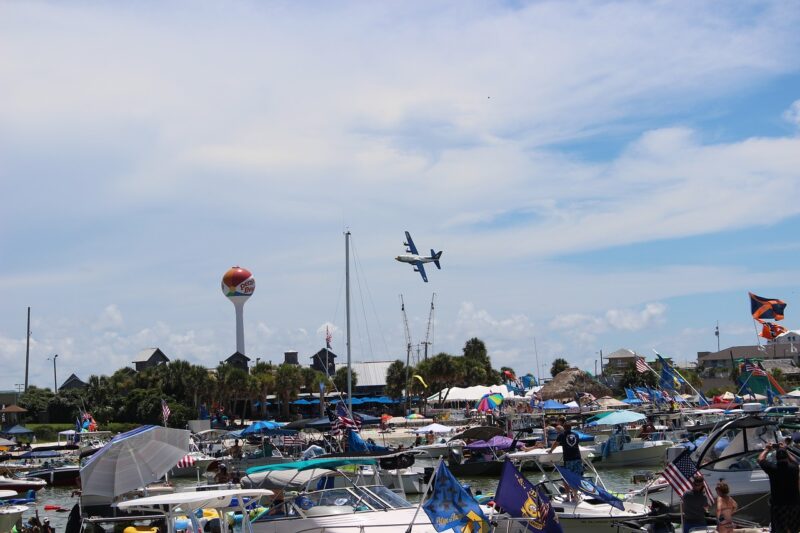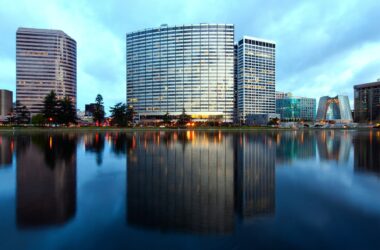Pensacola Weather: Pensacola is a coastal city located in the western part of the Florida Panhandle. This beautiful city is known for its stunning beaches, crystal-clear waters, and vibrant culture. The weather in Pensacola is one of the many things that make it an ideal vacation spot. The region has a warm and humid subtropical climate that provides a pleasant and comfortable experience for visitors all year round. In this article, we will explore everything there is to know about Pensacola weather, including the best time to visit, climate, temperature, rainfall, and more.
Climate of Pensacola
Pensacola is located in a subtropical climate zone, which means that the city experiences hot summers, mild winters, and high humidity throughout the year. The climate is influenced by the Gulf of Mexico, which moderates the temperature and humidity levels in the region. The average annual temperature in Pensacola is 70°F, with an average high of 80°F and an average low of 60°F.
The city experiences two distinct seasons: a long, hot, and humid summer from May to September and a mild winter from December to February. The transitional seasons of spring and fall are short and relatively mild, with temperatures ranging from the mid-60s to the mid-70s.
Best time to visit Pensacola
The best time to visit Pensacola is from late spring to early fall when the weather is warm and sunny, and the beaches are at their best. The peak season for tourism in Pensacola is from May to August when the temperatures are high, and the water is warm enough for swimming and water sports.
The shoulder season of September and October is also a great time to visit Pensacola, as the crowds are thinner, and the weather is still warm and pleasant. The off-season, from November to April, is the least popular time to visit Pensacola, as the temperatures can be cool, and some businesses may close during this period.
The temperature in Pensacola
Pensacola experiences hot and humid summers, with temperatures ranging from the mid-80s to the low 90s. The warmest months are July and August, with an average high of 91°F and an average low of 74°F. The winter months are relatively mild, with temperatures ranging from the mid-50s to the mid-60s. The coldest months are January and February, with an average high of 61°F and an average low of 43°F.
Rainfall in Pensacola
Pensacola receives an average annual rainfall of 65 inches, with the wettest months being June, July, and August. The city also experiences occasional thunderstorms and hurricanes, especially during the summer months. Visitors are advised to keep an eye on the weather forecast and be prepared for sudden weather changes.
Hurricane season in Pensacola
Pensacola is located in a region that is prone to hurricanes, especially during the summer and fall months. Hurricane season in Pensacola runs from June to November, with the highest risk of storms occurring in August and September. Visitors to Pensacola during hurricane season are advised to stay informed about weather updates and be prepared to evacuate in case of a storm.
Humidity in Pensacola
The humidity in Pensacola is high throughout the year, with an average relative humidity of 75%. The high humidity levels can make the temperatures feel much warmer than they actually are, especially during the summer months. Visitors are advised to stay hydrated and wear lightweight, breathable clothing to stay comfortable in humid conditions.
UV Index in Pensacola
Pensacola is located in an area with high levels of UV radiation, especially during the summer months. The UV index in Pensacola ranges from 4 to 11, with the highest levels occurring between 10 am and 4 pm. Visitors are advised to use sunscreen with a high SPF, wear a hat and sunglasses, and seek shade during peak UV hours to protect themselves from harmful UV rays.
Beach Conditions in Pensacola
Pensacola is famous for its stunning beaches, but the conditions on the beach can vary depending on the weather. During the summer months, the water is warm and perfect for swimming, snorkeling, and other water sports. However, the surf can sometimes be rough, and there may be ripped currents that can be dangerous for swimmers.
During the fall and winter months, the beaches are less crowded, and the surf can be calmer. However, the water temperature can be too cold for swimming, and visitors may need to wear a wetsuit to enjoy water sports.
Activities to Enjoy in Pensacola
Regardless of the weather, there are plenty of activities to enjoy in Pensacola. Here are some ideas for things to do in Pensacola, whatever the weather:
- Visit the National Naval Aviation Museum: This museum is one of the most popular attractions in Pensacola and features over 150 aircraft and spacecraft, including the famous Blue Angels.
- Explore the Pensacola Lighthouse and Museum: This historic lighthouse offers stunning views of the Gulf of Mexico and Pensacola Bay and is a great place to learn about the history of the area.
- Take a Dolphin Cruise: Pensacola Bay is home to a large population of dolphins, and a dolphin cruise is a great way to see these beautiful creatures up close.
- Visit the Gulf Islands National Seashore: This protected area includes over 40 miles of beautiful beaches and is a great place to enjoy hiking, swimming, and other outdoor activities.
- Explore Historic Downtown Pensacola: The historic downtown area of Pensacola is full of charming shops, restaurants, and galleries, and is a great place to explore on a rainy day.
Conclusion
Pensacola’s weather is one of the many things that make it an ideal vacation spot for visitors. With warm and humid summers, mild winters, and plenty of activities to enjoy, Pensacola is a great place to visit all year round. Whether you’re interested in lounging on the beach, exploring the local history, or trying new water sports, there’s something for everyone in Pensacola. So pack your bags and get ready to enjoy the sunshine and sea breeze in this beautiful coastal city!
Similar Articles
- Pensacola: A Vibrant Beach Destination with a Rich History
- Mobile Alabama Airport: The Gateway to the Gulf Coast
Frequently Asked Questions About Pensacola weather
Here are some frequently asked questions about Pensacola weather that visitors may find helpful:
- What is the best time of year to visit Pensacola?
Pensacola is a great place to visit all year round, but the best time to visit depends on your preferences. The summer months of June to August are the busiest and hottest, with temperatures ranging from the mid-80s to the low 90s. The fall months of September to November offer milder temperatures and fewer crowds, making it a great time to visit if you want to avoid crowds. The winter months of December to February are cooler but still mild, with temperatures ranging from the mid-50s to the low 60s. The spring months of March to May are also mild, with temperatures ranging from the mid-60s to the low 80s.
- What should I pack for a trip to Pensacola?
The weather in Pensacola can be hot and humid in the summer months and mild in the winter months, so visitors should pack accordingly. During the summer, lightweight and breathable clothing is recommended, along with sunscreen, a hat, and sunglasses. During the winter months, visitors should bring a sweater or jacket for cooler evenings. It is also recommended to bring comfortable shoes for exploring the beaches and downtown areas.
- Does Pensacola experience hurricanes?
Pensacola is located in a hurricane-prone area, and hurricanes can occur between June and November. Visitors are advised to keep an eye on weather reports and be prepared to evacuate if necessary. It is recommended to purchase travel insurance to cover unexpected cancellations or disruptions due to weather-related events.
- What is the water temperature in Pensacola?
The water temperature in Pensacola varies throughout the year. During the summer months, the water temperature can reach the mid-80s, making it ideal for swimming and other water activities. During the winter months, the water temperature can drop to the mid-50s, making it too cold for swimming for most visitors.
- What is the average rainfall in Pensacola?
Pensacola receives an average of 65 inches of rainfall per year, with the most rainfall occurring in the summer months of June to August. Visitors should be prepared for sudden afternoon thunderstorms during the summer months and bring a rain jacket or umbrella.
- Does Pensacola experience tornadoes?
While tornadoes can occur in Pensacola, they are relatively rare compared to other parts of the country. The most common time for tornadoes in Pensacola is during the spring and fall months.
- Can I swim in the ocean in Pensacola?
Yes, visitors can swim in the ocean in Pensacola, but the conditions can vary depending on the weather. During the summer months, the water is warm and ideal for swimming, but there can be strong surf and rip currents that can be dangerous for swimmers. Visitors are advised to check the surf conditions and heed any warnings posted by lifeguards. During the winter months, the water temperature can be too cold for swimming for most visitors.
- What is the best way to get around Pensacola?
The best way to get around Pensacola depends on the visitor’s preferences. Visitors can rent a car, take a taxi or rideshare service, or use the local public transportation system, which includes buses and trolleys. Biking is also a popular way to explore the beaches and downtown areas, and there are several rental options available.
- What is the air quality like in Pensacola?
Pensacola has relatively good air quality, with an air quality index (AQI) that is typically in the “good” to “moderate” range. However, visitors with respiratory issues may want to take precautions during periods of high pollution or pollen counts.
- Are there any weather-related attractions in Pensacola?
Yes, there are several weather-related attractions in Pensacola that visitors may find interesting. The National Naval Aviation Museum features exhibits on weather forecasting and its impact on aviation, while the Gulf Coast Exploreum Science Center has interactive exhibits on meteorology and climate science. The Pensacola Lighthouse and Museum also offer a fascinating look at the role of lighthouses in weather forecasting and navigation.









